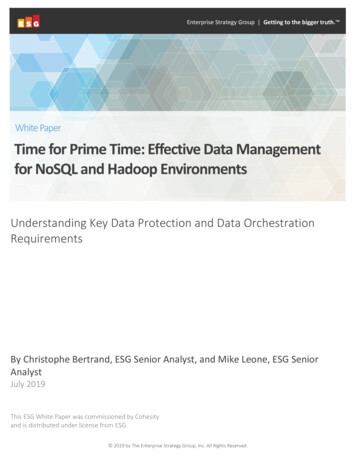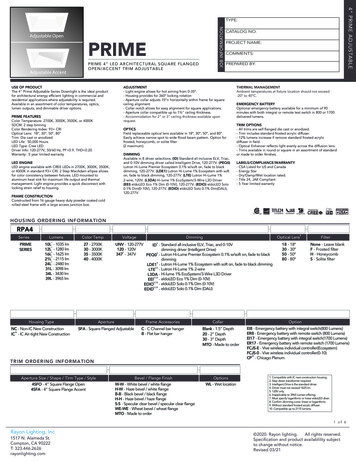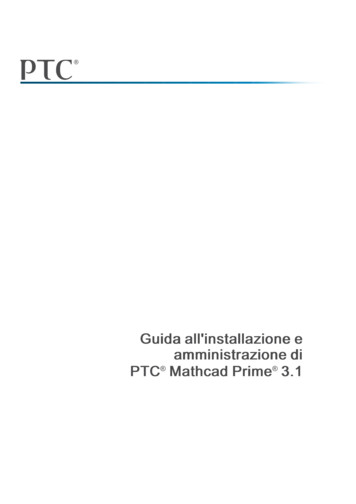
Transcription
Enterprise Strategy Group Getting to the bigger truth. White PaperTime for Prime Time: Effective Data Managementfor NoSQL and Hadoop EnvironmentsUnderstanding Key Data Protection and Data OrchestrationRequirementsBy Christophe Bertrand, ESG Senior Analyst, and Mike Leone, ESG SeniorAnalystJuly 2019This ESG White Paper was commissioned by Cohesityand is distributed under license from ESG. 2019 by The Enterprise Strategy Group, Inc. All Rights Reserved.
White Paper: Time for Prime Time: Effective Data Management for NoSQL and Hadoop Environments2ContentsIntroduction . 3Database Proliferation . 3Pervasiveness of NoSQL and the Cloud . 3Enter Hadoop . 4Business and IT Imperatives . 4Impact of Downtime and Data Loss . 4SLA Requirements for Production Applications and Databases . 5Mitigating the Ransomware Epidemic . 5The Role of Cloud . 5Key Data Management Considerations for Hadoop and NoSQL Deployments . 6Protection Considerations . 6Orchestration Is Critical . 6Flexible Migration Is a New Imperative . 6The Bigger Truth. 7 2019 by The Enterprise Strategy Group, Inc. All Rights Reserved.
White Paper: Time for Prime Time: Effective Data Management for NoSQL and Hadoop Environments3IntroductionAs organizations continue to look for ways to increase business agility, a need for a modern database architecture that canrapidly respond to the needs of business is more apparent than ever. While an RDBMS still serves as a lifeline for manyorganizations, the adoption of technologies such as NoSQL and Hadoop are enabling organizations to best addressdatabase performance and scalability requirements while also satisfying the goals of embracing hybrid cloud and becomingmore data-driven. And with organizations relying so heavily on these new technologies to yield rapid insights that positivelyimpact the business, the need to evaluate how those new technologies are managed and protected is essential. Hadoopand NoSQL workloads are now pervasive in production environments and require “production-class” data protection, yetfew data protection solutions offer such capabilities today.Database ProliferationESG research shows that 38% of organizations report that they have between 25 and 100 unique database instances, whileanother 20% have over 100. 1 The proliferation alone comes with significant cost, management, and data protectionchallenges, but the different types of database architectures (i.e., RDBMS versus NoSQL) and their locations (i.e., onpremises versus the public cloud) should not be overlooked.Pervasiveness of NoSQL and the CloudNoSQL databases are now the norm, with 78% of organizations reporting in 2017 that they were using a NoSQL database,while another 18% reported having plans for or being interested in using one within the following year. 2 By benefiting froma distributed architecture that can easily scale to meet the demands of the business while enabling organizations to easilytransition to the cloud, the pervasiveness of NoSQL is not that surprising. And with the cloud offering organizations costsavings, infrastructure flexibility, and higher availability, it makes sense that when asked about the most importantattributes and capabilities that organizations look for when evaluating and selecting a database, being cloud-based was thetop response (see Figure 1). 3 It is important to note that while cloud is being prioritized, this is not a scenario where alldatabase instances are being migrated to the cloud. While 62% of organizations currently use a cloud-based productiondatabase, just 10% of organizations said their primary infrastructure deployment strategy for net-new databasedeployments is a public cloud service. 4Figure 1. Top Five Attributes and Capabilities When Evaluating and Selecting DatabasesWhen evaluating and selecting databases, which of the following are the most importantattributes and capabilities to your organization? (Percent of respondents, N 354, threeresponses accepted)Cloud-based43%Encryption35%Full SQL complianceIn-memory processingScales up efficiently with larger systems32%26%23%Source: Enterprise Strategy GroupSource: ESG Survey, Enterprise Database Trends, January 2017. All ESG research references and charts in this white paper are taken from thisreport, unless otherwise noted.2 Source: ESG Brief, Market Disruption: Next-generation Databases, April 2017.3 Source: ESG Brief, Database Purchase Criteria, June 2017.4 Source: ESG Brief, The Database Market: Radical Shift to the Cloud, April 2017.1 2019 by The Enterprise Strategy Group, Inc. All Rights Reserved.
White Paper: Time for Prime Time: Effective Data Management for NoSQL and Hadoop Environments4Enter HadoopDatabases are the start, but to satisfy the data-driven initiatives, organizations must continue to enhance their databasedeployments with more robust infrastructure that can help with processing constantly growing datasets. This is whereplatforms like Hadoop and Spark come in.For Hadoop specifically, despite post-hype pessimism, the technology is still widely used, with ESG research showing that50% of organizations leverage the technology to some extent. So, how are organizations leveraging Hadoop alongside theirdatabases? The most-often cited way, with 35% of responses, is by leveraging Hadoop to offload, optimize, and/orcomplement an existing database. Thirty four percent of organizations are looking to use SQL queries on both Hadoop andother databases, while 33% view Hadoop as being a cheaper alternative to traditional databases. Thirty two percent feelHadoop better enables the discovery of data, and 32% also cite leveraging databases as a source of data for Hadoop.Figure 2. Top Five Ways Organizations Use Databases Alongside HadoopWhich of the following represents the manner(s) in which your organization uses or plans touse databases alongside Hadoop and/or data lakes implementations? (Percent ofrespondents, N 298, multiple responses accepted)Hadoop to offload, optimize, complement thedatabase35%Use SQL queries on both Hadoop and otherdatabases34%Hadoop as a cheaper alternative to traditionaldatabases33%Hadoop to enable data discovery32%Databases are a source of data for Hadoop32%Source: Enterprise Strategy GroupBusiness and IT ImperativesIn recently completed research, respondents surveyed by ESG identified that cost and improving SLAs for data andapplications are among the top data protection mandates from their organizations’ IT leadership. 5 This should come as nosurprise as impacts on production environments and their associated mission-critical applications and data can be verydamaging, sometimes caused by the ransomware epidemic that has spread across industries around the world.Impact of Downtime and Data LossESG’s real-world SLAs research points to organizations having very little tolerance for downtime for servers running “highpriority” workloads. Fourteen percent of organizations report tolerating no downtime ever, while another 36% can acceptless than 15 minutes. 6 This only highlights the criticality of having a solid backup and recovery infrastructure in place for allmission-critical production environments. NoSQL and Hadoop workloads, as outlined previously, fall in that category.Impacts of downtime or lost data can be catastrophic for organizations. ESG’s research identified direct loss of revenue,loss of customer confidence, missed business opportunity, loss of employee confidence, and damage to brand integrity as56Source: ESG Master Survey Results, 2018 Data Protection Landscape, to be published.Source: ESG Master Survey Results, Real-world SLAs and Availability Requirements, May 2018. 2019 by The Enterprise Strategy Group, Inc. All Rights Reserved.
White Paper: Time for Prime Time: Effective Data Management for NoSQL and Hadoop Environments5the five most commonly cited potential impacts. 7 Clearly, downtime and lost data are business issues that demand fullexecutive attention and mitigation measures.SLA Requirements for Production Applications and DatabasesZooming in on production environments and the amount of tolerable data loss, ESG identified that most organizationssimply don’t tolerate losing much data at all. IT leaders intuitively know that losing data that needs to be recreated isinherently an expensive exercise to be avoided. ESG’s research shows that 51% of organizations indicate that the thresholdis placed at 15 minutes of data loss, or how much data can be lost without significant impact to the business. The sameresearch also highlights that 16% of organizations can only tolerate less than five minutes of data loss for “high priority”data. 8 From a data protection perspective, this means that these environments must be protected very frequently orcontinuously. Recent trends such as the rise of ransomware and its consequences on data loss only reinforce thisrequirement.Mitigating the Ransomware EpidemicThere isn’t a week that passes without news breaking of another cyber-attack or ransomware extortion scheme. Mostrecently, big data databases have been specifically targeted. Cyber-attackers have even organized “competitions” focusedon MongoDB installations for example, with IT press reporting tens of thousands of attacks where the databases werepublicly exposed.A cyber event affecting the integrity or availability of data is akin to a logical corruption event in data protection terms, onethat requires remediation via recovery. To recover and minimize data loss, a recent backup must be available and meet theservice levels mandated by IT and organizational leadership. This means that data protection service levels such asrecovery point objectives (RPOs) and recovery time objectives (RTOs) are aligned with best practices for productionenvironments to minimize business impact and disruption. It also means that frequent backups that allow a “rollback” to apre-attack time is a best practice to implement in combination with ransomware-specific mitigation capabilities, such asearly detection, flagging/warnings, etc.The Role of CloudThe adoption of cloud as an extension to “traditional” on-premises environments is a reality across the board: ESG research shows that the adoption of cloud and multi-cloud environments has accelerated over the past fewyears. Overall adoption of public cloud has gone from 57% of organizations using in 2013 to 85% today. 9 As users consider deploying new applications, they often turn to cloud for those deployments either as a part of a“cloud-first” strategy (29%) or a hybrid on-premises/cloud approach (47%). 10 The number of organizations running production applications on public cloud infrastructure continues to climb with46% of current IaaS users doing so in 2018, up from only 27% three years ago. 11The research is clear: Cloud has become a key component of production environments, replacing or extending the datacenter.ibid.ibid.9 Source: ESG Master Survey Results, 2018 IT Spending Intentions Survey, December 2017.10 ibid11 Source: ESG Brief, 2018 Public Cloud Infrastructure Trends , April 2018.78 2019 by The Enterprise Strategy Group, Inc. All Rights Reserved.
White Paper: Time for Prime Time: Effective Data Management for NoSQL and Hadoop Environments6For this reason, the flexibility to move these workloads, to migrate them or repatriate them, is an important capability toconsider as part of the deployment process to optimize operational efficiency. In the context of big data databases, thisflexibility/mobility also supports the efficiency of the development and management teams.Key Data Management Considerations for Hadoop and NoSQL DeploymentsHadoop and NoSQL environments are pervasive and support many organizations’ business processes as outlinedpreviously. Protecting these business-critical workloads is a mandate for IT, as is establishing processes for leveraging clouddestinations and movement in and out of the data center.Protection ConsiderationsNoSQL environments and Hadoop environments do not come with easy-to-deploy, built-in data protection. While severalutilities exist, they typically require expertise and custom coding that is not always easy to deploy or maintain.There is a false sense of security because NoSQL and Hadoop databases are inherently self-replicating, which only coversthe risk of hardware failure/node failure. Also, production NoSQL and Hadoop environments can quickly grow in scale andbe very distributed, making the process of backup and recovery more time consuming unless scalable and modern dataprotection techniques are used, such as point-in-time backup and recovery, incremental-forever backup, granularrecoveries, no agents, etc.There are many “flavors” of NoSQL in the market today (Mongo DB, Cassandra, Couchbase, etc.). It is important that thebackup and recovery solution not only scales, but also maintains awareness of the types of databases it is protecting, andtheir nuances, to deliver a unified, coherent, and consistent backup process as well as granular recoverability. Awarenessof data can also support compliance or privacy requirements with data masking, for example.Finally, hybrid/cloud support and movement off-premises and back on-premises are critical for operational efficiency andIT flexibility. This is where orchestration can play a role.Orchestration Is CriticalThe data protection process is a workflow of events or operations that need to take place in a predefined sequence, orrunbook. Many steps need to take place to ensure the proper backup, recovery, or migration of a NoSQL environment.Leveraging a robust policy engine is an architectural requirement that powers many data operations such as data masking,data mirroring, and the very critical incremental backup process, among others.With these data-aware orchestration capabilities, organizations can optimize their archiving process, support testing anddevelopments functions by providing “real” data clones, and better manage cloud migration efforts.Flexible Migration Is a New ImperativeAs organizations have now extended their on-premises environments to include cloud destinations, “freedom” or flexibilityof movement of production workloads is an operational must have, whether moving NoSQL and Hadoop workloads acrossdata centers, from on-premises to cloud, or from any source to any destination.The ability to leverage automation is much needed given the scale of complexity of these databases. It is necessary forobvious operational efficiency reasons, but also to improve the recoverability of these environments.Taking human error out of the management and data protection loops is becoming a reality as more machine learning andartificial intelligence capabilities get integrated in modern data backup and management solutions. With more automation 2019 by The Enterprise Strategy Group, Inc. All Rights Reserved.
White Paper: Time for Prime Time: Effective Data Management for NoSQL and Hadoop Environments7and intelligence accompanying IT, it is easier to reduce the impact of ransomware, optimize data recovery service levels,and operate more autonomous environments, freeing up precious IT or development resources to support the business.The Bigger TruthHadoop and NoSQL backups using traditional data protection methods are no longer enough. The proliferation of Hadoopand NoSQL in what can be petabyte-scale creates business and IT imperatives of stringent data protection SLAs. The risk ofdata loss, the threats that exist with ransomware, and best recoverability practices to support business objectives meanthat IT leaders must apply enterprise-class data protection solutions to be ready for production prime time. Protection onlyis not enough: Orchestration is key and requires intelligence capabilities to better enable IT to manage complex dataprotection operations and migrate these workloads seamlessly between/across cloud and on-premises environments.That’s where Cohesity can help. The company focuses on enterprise data management and has recently added a solutionfor Hadoop and NoSQL environments running on-premises or in the public cloud. Cohesity’s solution is architected forpetabyte scale, data-aware, and powered by machine learning. Its most recent version, version 6.3, added some strongcapabilities in the areas of policy automation, ransomware mitigation, and advanced granular backup and recovery.IT leaders evaluating their data protection strategies for production Hadoop and NoSQL environments should put Cohesityon their lists based on its breadth and depth of functionality for these environments, and for its innovative use of machinelearning and automation.All trademark names are property of their respective companies. Information contained in this publication has been obtained by sources TheEnterprise Strategy Group (ESG) considers to be reliable but is not warranted by ESG. This publication may contain opinions of ESG, which are subjectto change from time to time. This publication is copyrighted by The Enterprise Strategy Group, Inc. Any reproduction or redistribution of thispublication, in whole or in part, whether in hard-copy format, electronically, or otherwise to persons not authorized to receive it, without the expressconsent of The Enterprise Strategy Group, Inc., is in violation of U.S. copyright law and will be subject to an action for civil damages and, if applicable,criminal prosecution. Should you have any questions, please contact ESG Client Relations at 508.482.0188.Enterprise Strategy Group is an IT analyst, research, validation, and strategy firm that providesactionable insight and intelligence to the global IT community. 2019 by The Enterprise Strategy Group, Inc. All Rights Reserved.www.esg-global.com 2019 by The Enterprisecontact@esg-global.comStrategy Group, Inc. All Rights Reserved.P. 508.482.0188
for NoSQL and Hadoop Environments White Paper . White Paper: Time for Prime Time: Effective Data Management for NoSQL and Hadoop Environments 2 . Hadoop better enables the discovery of data, and 32% also cite leveraging databases as a source of data for Hadoop. Figure 2. Top Five Ways Organizations Use Databases Alongside Hadoop










